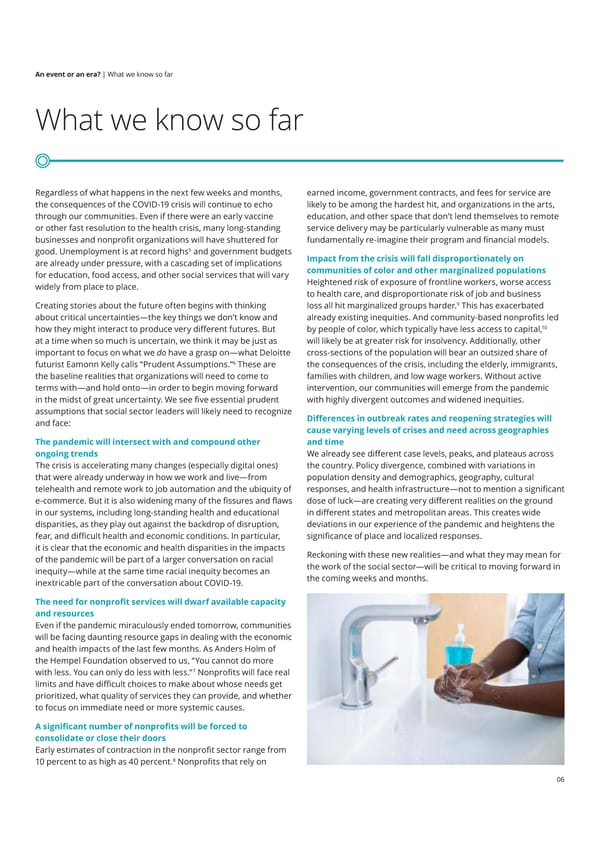An event or an era? | What we know so far What we know so far Regardless of what happens in the next few weeks and months, earned income, government contracts, and fees for service are the consequences of the COVID-19 crisis will continue to echo likely to be among the hardest hit, and organizations in the arts, through our communities. Even if there were an early vaccine education, and other space that don’t lend themselves to remote or other fast resolution to the health crisis, many long-standing service delivery may be particularly vulnerable as many must businesses and nonprofit organizations will have shuttered for fundamentally re-imagine their program and financial models. 5 good. Unemployment is at record highs and government budgets Impact from the crisis will fall disproportionately on are already under pressure, with a cascading set of implications communities of color and other marginalized populations for education, food access, and other social services that will vary Heightened risk of exposure of frontline workers, worse access widely from place to place. to health care, and disproportionate risk of job and business 9 Creating stories about the future often begins with thinking loss all hit marginalized groups harder. This has exacerbated about critical uncertainties—the key things we don’t know and already existing inequities. And community-based nonprofits led 10 how they might interact to produce very different futures. But by people of color, which typically have less access to capital, at a time when so much is uncertain, we think it may be just as will likely be at greater risk for insolvency. Additionally, other important to focus on what we do have a grasp on—what Deloitte cross-sections of the population will bear an outsized share of 6 futurist Eamonn Kelly calls “Prudent Assumptions.” These are the consequences of the crisis, including the elderly, immigrants, the baseline realities that organizations will need to come to families with children, and low wage workers. Without active terms with—and hold onto—in order to begin moving forward intervention, our communities will emerge from the pandemic in the midst of great uncertainty. We see five essential prudent with highly divergent outcomes and widened inequities. assumptions that social sector leaders will likely need to recognize Differences in outbreak rates and reopening strategies will and face: cause varying levels of crises and need across geographies The pandemic will intersect with and compound other and time ongoing trends We already see different case levels, peaks, and plateaus across The crisis is accelerating many changes (especially digital ones) the country. Policy divergence, combined with variations in that were already underway in how we work and live—from population density and demographics, geography, cultural telehealth and remote work to job automation and the ubiquity of responses, and health infrastructure—not to mention a significant e-commerce. But it is also widening many of the fissures and flaws dose of luck—are creating very different realities on the ground in our systems, including long-standing health and educational in different states and metropolitan areas. This creates wide disparities, as they play out against the backdrop of disruption, deviations in our experience of the pandemic and heightens the fear, and difficult health and economic conditions. In particular, significance of place and localized responses. it is clear that the economic and health disparities in the impacts Reckoning with these new realities—and what they may mean for of the pandemic will be part of a larger conversation on racial the work of the social sector—will be critical to moving forward in inequity—while at the same time racial inequity becomes an the coming weeks and months. inextricable part of the conversation about COVID-19. The need for nonprofit services will dwarf available capacity and resources Even if the pandemic miraculously ended tomorrow, communities will be facing daunting resource gaps in dealing with the economic and health impacts of the last few months. As Anders Holm of the Hempel Foundation observed to us, “You cannot do more 7 with less. You can only do less with less.” Nonprofits will face real limits and have difficult choices to make about whose needs get prioritized, what quality of services they can provide, and whether to focus on immediate need or more systemic causes. A significant number of nonprofits will be forced to consolidate or close their doors Early estimates of contraction in the nonprofit sector range from 8 10 percent to as high as 40 percent. Nonprofits that rely on 06
 US Deloitte Monitor Institute Page 5 Page 7
US Deloitte Monitor Institute Page 5 Page 7